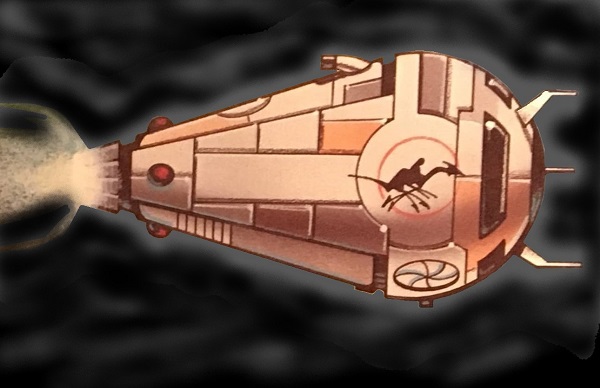Condottiere
SOC-14 5K


Last edited:


Time between jumps is almost always under 4 hours, and the record is under 7 minutes, making the speed of the communication nearly the speed of jump
High population and high technology star systems can be expected to have up to twelve xboats present at one time, probably distributed evenly between arriving and departing ships.
Lower population systems will have fewer xboats. The presence of a scout base will increase the probability of xboats being present.
Imperial Way Stations, maintained by the scouts to service and overhaul all scout vessels, will have many xboats present, although most will be in some state of disrepair.
This is why, now that I'm thinking about the question more deliberately, I'm thinking that Type-S Scout/Couriers can act as streamlined fuel shuttles supporting XBoat Tender operations when there isn't a gas giant around to skim for fuel. For one thing, the Scout/Couriers are going to be present ANYWAY just to take communications "off route" from the Express Network systems, although their operational tempo won't be the same as the XBoats and Tenders themselves. That means the Scout/Couriers can be tasked with "milk runs" for refueling Tenders as needed, and with 2G maneuver drives they can safely make soft landings on water oceans for scoop runs from surface to orbit on repeat to refuel a Tender on station.I think tenders would have have fuelers serving them. Streamlined system boats with fuel scoops/processors. They circuit with gas giants and the tenders to refuel them. No sense in the tender wasting effort scooping and processing fuel if it doesn't need to.
Insert another step:
- Communications Specialist aboard Tender sorts and consolidates communications.
- Tender beams communications to XBoat(s) 2+ already ready for departure.
Sounds a lot like a Shadowrun adventure ...It also gives you scenario material. The players have to infiltrate the X-boat / scout side of the station and retrieve a package or data from a secure location for a patron who's paying big bucks to them to get it. A further problem is even if they are successful, they are now potentially targets of a rather angry--putting it mildly--megacorporation, noble(s), or the government who is seeking to ID and eliminate them for exposing whatever was in the package or data.
Your senors all operate at the speed of light. A radar signal trying to detect an object at 3o million kilometers takes 100 seconds to reach that distance, and another 100 seconds for a very, very reduced return signal to reach the receiver. That is 3 minutes and 20 seconds. As you are in a planetary system, the receiver is going to be moving as well. Now, this is for a single radar pulse in a single direction. Would you care to consider how long it would take to search out to 30 million kilometers over a complete sphere of coverage? Would you also care to speculate on how many chunks of rock and other debris you will pick up? Thirty million kilometers does not even come close to reaching the orbit of Mars in our system. I cannot even conceive ot some form of traffic control out to even the orbit of Jupiter, much less Pluto.Hi!
I'm preparing a starting adventure for my group. They get a ship via a bankrupt shipping company.
The ship is somewhere in the Garda Vilis system and the players have to find it. Of course the ship is
not at a starport and they have to do investigations to get some clues, where in the system the ship
might be.
There is traffic control for planets and starports and the COACC, but what about the rest of the system?
My question is, if there is some kind of a systemwide traffic control in Traveller for a star system?
If someone could help me out in this matter or direct me to some stuff for reading, that would be great.
Thank you!
